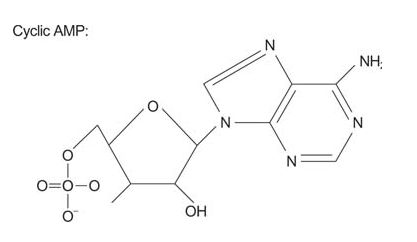Cyclic AMP: A Second Messenger
The action of epinephrine illustrates the principles by which cyclic AMP mediates hormone action. Epinephrine is the “flight or fight hormone” that the adrenal glands release in response to stress. The hormone causes an increase in blood pressure and the breakdown of glucose for energy. This helps humans in danger to engage in physical activity to meet the challenges of a situation. The body responds with a dry mouth, rapid heartbeat, and high blood pressure. A biochemical chain of events leads to these responses.
When epinephrine binds to cells, it stays outside on the membrane‐bound receptor. The second messenger, cyclic AMP, is made by the enzyme adenylate cyclase.

![]()
Adenylate cyclase is a two‐component enzyme system. It ultimately catalyzes the cyclase reaction, but only when it is associated with the hormone‐bound receptor and a regulatory protein called a stimulatory G‐protein (guanylate nucleotide binding protein), which activates adenylate cyclase. The G‐protein is the intermediate between the receptor and the synthesis of cyclic AMP.
G‐proteins exist either in an active or an inactive state, depending on the guanylate nucleotide that is bound. In the inactive state, G‐protein binds to GDP. In the active state, GTP is bound to the G‐protein. G‐proteins have an intrinsic GTPase activity, which converts bound GTP to GDP. Hydrolysis of GTP by the G‐protein converts the G‐protein back to an inactive state. Thus the cycle of the G‐protein is as follows:
- Hormone binds to receptor.
- The hormone‐bound receptor binds to the G‐protein and causes GDP to be replaced by GTP.
- GTP‐bound G‐protein interacts with adenylate cyclase.
- G‐protein hydrolyzes bound GTP to GDP, thereby going back to the ground state.
Different G‐proteins may either stimulate or inhibit adenylate cyclase to make more or less cyclic AMP.

Figure 1
Action of cyclic AMP
Cyclic AMP doesn't act directly on its target enzymes; for example, glycogen phosphorylase and glycogen synthase. Instead, cyclic AMP stimulates a protein kinase cascade that ultimately leads to a cellular response. Cyclic AMP binds to protein kinase A, which then catalyzes the transfer of phosphate from ATP to a serine residue on a second enzyme, phosphorylase kinase, which itself transfers a phosphate to glycogen phosphorylase. Active glycogen phosphorylase then catalyzes the breakdown of glycogen to glucose‐1‐phosphate. This provides energy for muscle activity.
Cells can't be “turned on” forever. Something must modulate the response. In fact, each step is reversible. Starting from the target proteins, a protein phosphatase hydrolyzes the phosphate from the proteins. Cyclic AMP is hydrolyzed by a phosphodiesterase.
Perhaps a key point in the modulation system is GTP hydrolysis by the G‐protein. This causes adenylate cyclase to return to the unstimulated state.
All signaling mechanisms must have this modulation feature to allow the possibility of control. For example, the Ras protein of mammalian cells is a membrane‐bound GTPase. Mutations that decrease Ras's GTPase activity can contribute to uncontrolled growth (i.e., tumor formation) of mammalian cells.